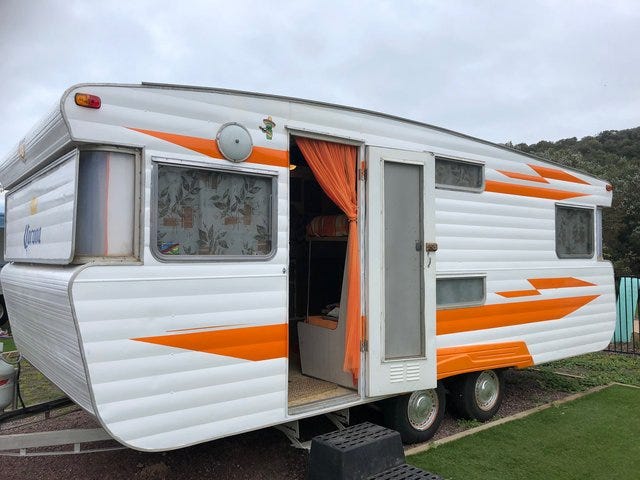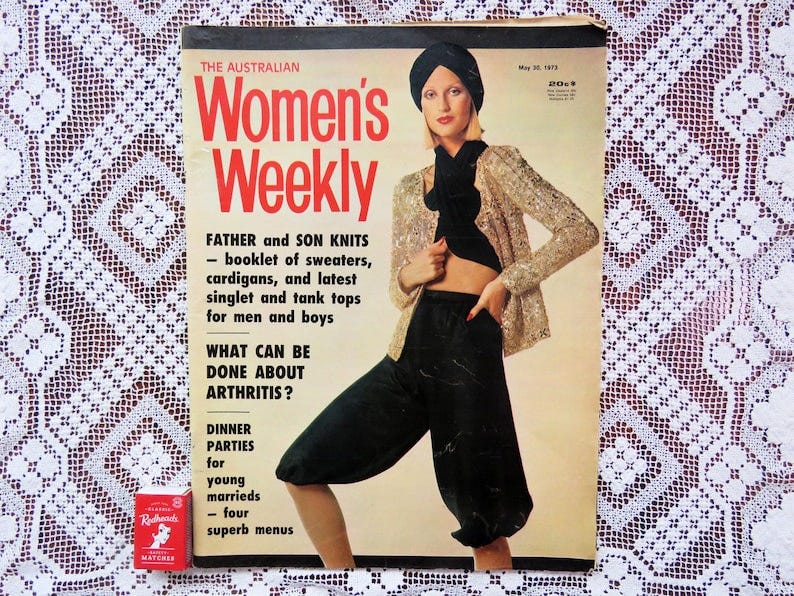May 1973 ~ Aussie Board
Reading 1973: a quick guide for non-Australian readers
Renovations, archives, laps on the school oval, and quiet acts of care. This month’s textures come from regional bureaucracy, civic libraries, PE culture, and the small mercies of snacks, cars, and birds.
Where we are
Caravan park under renovation.
Seasonal shutdowns with blunt hand-painted signage were common. “Temporarily Closed for Renovations” reads like a council voice, practical and unfussy. Empty vans, rolled awnings, a lonely tyre swing, all feel exactly country-Australia between holiday peaks.
Library back-rooms.
Town libraries often kept unlocked archive doors and typed Staff Only cards. Inside you’d find bound broadsheets, labelled boxes out of order, and a long table sagging with manila folders. Dust, binder glue, and old ink are the smell of civic memory.
Civic Centre benches.
Brick ledges and breezeways outside council buildings and libraries are true to 70s public design. They give kids a neutral place to perch where adults can clock what matters without making a scene.
Everyday textures
Galahs and gums. Pink-grey cockatoos pecking on dry grass and the scrape of gum leaves along bitumen are inland signatures.
Glass-bottle lemonade. Cold soft drink handed to a kid to press on a bruise is a very Australian act of wordless care.
Corn snacks and sticky fingers. Twisties dust on hands is playground currency.
Beige sedans. A neat, no-nonsense family Ford with eucalyptus scent is suburban transport 101.
School and sport
The oval. PE happens on a grass oval that bakes to dust at the edges. Laps are the baseline drill.
Teacher tone. Short, provocative lines in front of peers were a tolerated authority style in 1973. It stings, and that sting is era-true.
Free write. Teachers who loved language sometimes set open prompts with no hand-holding. Chalk title, one line of instruction, trust the page.
Speech and register
G’day. Everyday greeting, casual as a nod.
Mate. Can be friendly, teasing, or barbed, depending on tone.
Fairy. A period-typical slur aimed at boys read as effeminate. It appears here as part of the harm the era normalised.
Library and print culture
The Australian Women’s Weekly. Mass-market magazine you could find face-down on a library table, half-read by teens and aunties alike.
Scrapbooks. Red-cardboard school scrapbooks were standard for projects. Cutting and pasting headlines into one is precisely how a 70s kid would build a private archive.
Small Australian mercies
A dad figure who does not pry, offers a lift, and stops two houses short. A friend who passes Twisties and sits close without questions. A bottle of lemonade pressed into a sore hand. These are quiet local gestures that say care without ceremony.
A mini glossary from the chapter
Thongs: flip-flops.
Oval: grass sports field used for PE and lunch.
Breezeway: covered outdoor corridor between classrooms or buildings.
Twisties: bright orange corn snacks, very popular.
Women’s Weekly: shorthand for The Australian Women’s Weekly magazine.
Archives: the library’s back-room of bound newspapers and clippings.
Caravan park: holiday park with powered van sites and amenities.
Then and now
Caravan parks still close for works, though signs are printed now, not hand-painted. Many library archives have moved to digitised systems, but the smell of bound newsprint remains if you find the right room. PE still runs on ovals, with more duty of care and less bite in the banter. Lemonade comes in plastic more often than glass. The casual slurs that slide through 1973 are no longer acceptable, and that shift matters to how we read the harm on the page.
May’s scenes aren’t about grand national moments. They are about how a regional place actually feels: the bureaucratic voice on a gate, the unlocked archive door, the dust on an oval, and the thousand small ways Australians show care without making a fuss.
Questions welcome
If anything still felt unfamiliar, say where you stumbled in the comments, and I will expand this guide so the next reader can ride the current more easily.







